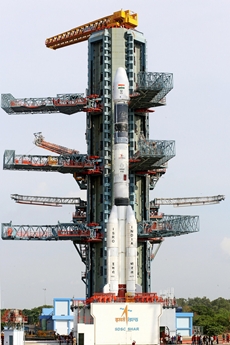Isro tastes success with cryogenic engine in INSAT-3DR launch
08 Sep 2016
The Indian Space research Organisation (Isro) today successfully used a GSLV-MKII rocket propelled by an indigenously developed cryogenic engine on an operational flight when it place one of the heaviest satellites in the INSAT/GSAT series on orbit.
 The 49 meter tall GSLV-MKII-F05 lifted off from the second launch pad at the Satish Dhawan Space Centre in Sriharikota to a perfect launch and making India self reliant in launching heavier satellites.
The 49 meter tall GSLV-MKII-F05 lifted off from the second launch pad at the Satish Dhawan Space Centre in Sriharikota to a perfect launch and making India self reliant in launching heavier satellites.
The INSAT-3DR is an advanced weather satellite. With a mass of 2,211 kg, including 1,255 kg of propellants, the satellite features carbon fibre construction. It also incorporates improvements over older INSAT-3 satellites and has the ability to provide night time images of cloud and fog cover. It can also estimate sea surface temperature with better accuracy.
The INSAT-3DR satellite, which can also aid in search and rescue (SAR) operations, was paced into a geosynchronous transfer orbit (GTO) around 17 minutes into the flight.
Isro can now launch satellites weighing around 2-2.5 tonnes till such time it readies an advanced GSLV variant - GSLV-Mark III - that can carry satellites weighing around four tonnes
The GSLV is a three-stage rocket where the first stage is fired by solid fuel and its four strap-on motors by liquid fuel, the second is powered by liquid fuel and the third used the Isrro-developed cryogenic engine that is more efficient as it provides more thrust for every kilogram of propellant burnt.
Isro, which currently relies on European Space Agency's Ariane rocket to launch its heavy communication satellites, is in the process of perfecting the crucial cryogenic engine technology to save precious foreign exchange by launching heavier satellites on its own.
The country pays around Rs500 crore ($75 million) as the launch fee for sending up a 3.5 tonne communication satellite, apart form the cost of making the satellite.
The mission designated F05, is Isro's ninth flight using cryogenic engines after a failed test in 2001. Eight flights have been conducted after that over the following 14 years. These included five using Russian cryogenic engine onboard and three others using indigenously developed ones. Of these, three succeeded, four failed and one was a partial success.
Isro successfully test-flew a rocket using indigenously developed cryogenic engine in January 2014.
The GSLV rocket has three variants, which include Mk-I, Mk-II and Mk-III. All three have a solid-fuel first stage and a liquid-fuel second stage. The Mk-I uses cryogenic engines of Russian make for the third stage. The Mk-II uses four liquid-fuel strap-on boosters in addition to the first stage and the CE-7.5 indigenous cryogenic engine for the third. The Mk-III will use two solid-fuel boosters for the first stage and the CE-20 indigenous cryogenic engine for the third.
Isro had planned to develop a cryogenic engine for use in its rockets as far back as in 1986. But the selection of a partner from erstwhile Soviet Union over costly US and French technology proved disastrous for India's cryogenic quest.
Isro's selection of a company called Glavkosmos from the erstwhile Soviet Union annoyed the US, which imposed sanctions on India and Russia after Isro and the Russian company refused to call their deal. However, the Boris Yeltsin government in Russia pressured Glavkosmos to call off its partnership.
Isro was left to fend for itself. But, the seven cryogenic engines supplied by Glavkosmos helped Isro to develop indigenous engines.
The INSAT-3DR satellite is a follow up of INSAT-3D satellite, which was launched in 2013. Both are meteorological satellites and are upgrades of the KALPANA-1 and the INSAT-3A. KALPANA-1 and INSAT-3A satellites.
The F05 mission on 8 September will see the GSLV-MkII launch the INSAT-3DR into the geostationary transfer orbit. From there, the satellite will use its built-in propulsion systems to manoeuvre into its eventual geosynchronous orbit.
The INSAT-3DR will be capable of mapping vertical changes of humidity, temperature and ozone content in Earth's atmosphere measurements – as well as capture better images of night-time clouds, and better measure sea surface temperature. Like INSAT-3D, the INSAT-3DR will also include a search-and-rescue transponder, used to pinpoint the location of distressed vessels at sea.
The 3D will operate until 2021. The 3DR will last till around 2024. A second successor, INSAT-3DS, is expected to operate from 2022 to 2029. The 3B and 3C are not operational.













.jpg)






.jpg)









